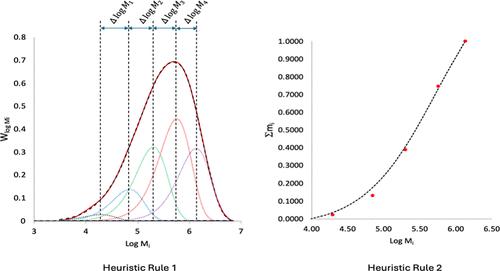聚烯烃mwd的自动反卷积:基于Flory最可能分布的启发式方法
IF 5.2
1区 化学
Q1 POLYMER SCIENCE
引用次数: 0
摘要
尽管分子量分布(MWD)反褶积方法在聚烯烃反应工程中很受欢迎,但尚未设计出系统的程序来对反褶积参数进行初始猜测。通过将两个或多个Flory最可能分布(mpd)拟合到实验测量数据中,MWD反卷积确定了描述由多位点型催化剂制备的聚烯烃的MWD所需的Flory最可能分布(mpd)的最小数量。目前的反卷积算法依赖于非线性最小二乘(NLLS)方法,并且需要对聚合物群体的数平均分子量(Mnj)和质量分数(mj)进行首次猜测。本文介绍了两个启发式规则,为mj和mj提供了系统的首次猜测,这是实现MWD反卷积自动化的重要一步。我们还提出了一种自适应加权策略,该策略将分子量平均值纳入目标函数而不影响收敛性。总之,这些发展表明,随钻反褶积不仅可靠,而且可预测,为其在催化剂筛选、工艺优化和高通量实验中的应用开辟了道路。本文章由计算机程序翻译,如有差异,请以英文原文为准。

Automated Deconvolution of Polyolefin MWDs: A Heuristic Approach Based on Flory Most Probable Distributions
Despite the popularity of molecular weight distribution (MWD) deconvolution methods in polyolefin reaction engineering, no systematic procedure has been devised to generate initial guesses for the deconvolution parameters. MWD deconvolution identifies the minimum number of Flory most probable distributions (MPDs) needed to describe the MWD of polyolefins made with multiple-site-type catalysts by fitting two or more Flory MPDs to the experimentally measured data. Current deconvolution algorithms rely on nonlinear least-squares (NLLS) methods and require first guesses for the number-average molecular weight (Mnj) and mass fraction (mj) of the polymer populations. This article introduces two heuristic rules that provide systematic first guesses for Mnj and mj, an essential step toward the automation of MWD deconvolution. We also propose an adaptive weighting strategy that incorporates molecular weight averages into the objective function without compromising convergence. Together, these developments demonstrate that MWD deconvolution can be made not only reliable but also predictable, opening the way for its use in catalyst screening, process optimization, and high-throughput experimentation.
求助全文
通过发布文献求助,成功后即可免费获取论文全文。
去求助
来源期刊

Macromolecules
工程技术-高分子科学
CiteScore
9.30
自引率
16.40%
发文量
942
审稿时长
2 months
期刊介绍:
Macromolecules publishes original, fundamental, and impactful research on all aspects of polymer science. Topics of interest include synthesis (e.g., controlled polymerizations, polymerization catalysis, post polymerization modification, new monomer structures and polymer architectures, and polymerization mechanisms/kinetics analysis); phase behavior, thermodynamics, dynamic, and ordering/disordering phenomena (e.g., self-assembly, gelation, crystallization, solution/melt/solid-state characteristics); structure and properties (e.g., mechanical and rheological properties, surface/interfacial characteristics, electronic and transport properties); new state of the art characterization (e.g., spectroscopy, scattering, microscopy, rheology), simulation (e.g., Monte Carlo, molecular dynamics, multi-scale/coarse-grained modeling), and theoretical methods. Renewable/sustainable polymers, polymer networks, responsive polymers, electro-, magneto- and opto-active macromolecules, inorganic polymers, charge-transporting polymers (ion-containing, semiconducting, and conducting), nanostructured polymers, and polymer composites are also of interest. Typical papers published in Macromolecules showcase important and innovative concepts, experimental methods/observations, and theoretical/computational approaches that demonstrate a fundamental advance in the understanding of polymers.
 求助内容:
求助内容: 应助结果提醒方式:
应助结果提醒方式:


